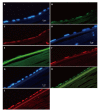Transplanting embryonic stem cells onto damaged human corneal endothelium
- PMID: 28928909
- PMCID: PMC5583531
- DOI: 10.4252/wjsc.v9.i8.127
Transplanting embryonic stem cells onto damaged human corneal endothelium
Abstract
Aim: To investigate whether human embryonic stem cells (hESCs) could be made to attach, grow and differentiate on a human Descemet's membrane (DM).
Methods: Spontaneously differentiated hESCs were transferred onto a human corneal button with the endothelial layer removed using ocular sticks. The cells were cultured on a DM for up to 15 d. The genetically engineered hESC line expressed green fluorescent protein, which facilitated identification during the culture experiments, tissue preparation, and analysis. To detect any differentiation into human corneal endothelial-like cells, we analysed the transplanted cells by immunohistochemistry using specific antibodies.
Results: We found transplanted cells form a single layer of cells with a hexagonal shape in the periphery of the DM. The majority of the cells were negative for octamer-binding transcription factor 4 but positive for paired box 6 protein, sodium potassium adenosine triphosphatase (NaKATPase), and Zona Occludens protein 1. In four of the 18 trials, the transplanted cells were found to express CK3, which indicates that the stem cells differentiated into corneal epithelial cells in these cases.
Conclusion: It is possible to get cells originating from hESCs to become established on a human DM, where they grow and differentiate into corneal endothelial-like cells in vitro.
Keywords: Cornea; Descemet’s membrane; Embryonic stem cells; Endothelium; Immunohistochemistry.
Conflict of interest statement
Conflict-of-interest statement: Catarina Ellerström is an employee of Takara Bio Europe AB. To the best of our knowledge, no conflict of interest exists for the other authors.
Figures


Similar articles
-
Transplantation of human embryonic stem cells onto a partially wounded human cornea in vitro.Acta Ophthalmol. 2013 Mar;91(2):127-30. doi: 10.1111/j.1755-3768.2011.02358.x. Epub 2012 Jan 26. Acta Ophthalmol. 2013. PMID: 22280565 Free PMC article.
-
Transplantation of adult human corneal endothelium ex vivo: a morphologic study.Cornea. 2001 Oct;20(7):731-7. doi: 10.1097/00003226-200110000-00012. Cornea. 2001. PMID: 11588426
-
Efficient Generation of Human Embryonic Stem Cell-Derived Corneal Endothelial Cells by Directed Differentiation.PLoS One. 2015 Dec 21;10(12):e0145266. doi: 10.1371/journal.pone.0145266. eCollection 2015. PLoS One. 2015. PMID: 26689688 Free PMC article.
-
[Transplantation of corneal endothelial cells].Nippon Ganka Gakkai Zasshi. 2002 Dec;106(12):805-35; discussion 836. Nippon Ganka Gakkai Zasshi. 2002. PMID: 12610838 Review. Japanese.
-
Biomechanical relationships between the corneal endothelium and Descemet's membrane.Exp Eye Res. 2016 Nov;152:57-70. doi: 10.1016/j.exer.2016.09.004. Epub 2016 Sep 14. Exp Eye Res. 2016. PMID: 27639516 Free PMC article. Review.
Cited by
-
Regenerating Eye Tissues to Preserve and Restore Vision.Cell Stem Cell. 2018 Jun 1;22(6):834-849. doi: 10.1016/j.stem.2018.05.013. Cell Stem Cell. 2018. PMID: 29859174 Free PMC article. Review.
-
An Insight into the Difficulties in the Discovery of Specific Biomarkers of Limbal Stem Cells.Int J Mol Sci. 2018 Jul 6;19(7):1982. doi: 10.3390/ijms19071982. Int J Mol Sci. 2018. PMID: 29986467 Free PMC article. Review.
-
Ocular Sticks for Routine Ophthalmic Surgery: A Randomized Controlled Monocentric Trial.Ophthalmol Ther. 2025 Apr;14(4):659-673. doi: 10.1007/s40123-025-01107-0. Epub 2025 Feb 15. Ophthalmol Ther. 2025. PMID: 39955441 Free PMC article.
-
Long-Term Observation and Sequencing Analysis of SKPs-Derived Corneal Endothelial Cell-Like Cells for Treating Corneal Endothelial Dysfunction.Cell Transplant. 2021 Jan-Dec;30:9636897211017830. doi: 10.1177/09636897211017830. Cell Transplant. 2021. PMID: 34053246 Free PMC article.
-
Adipose tissue stem cells in regenerative medicine.Ecancermedicalscience. 2018 Mar 28;12:822. doi: 10.3332/ecancer.2018.822. eCollection 2018. Ecancermedicalscience. 2018. PMID: 29662535 Free PMC article. Review.
References
-
- Levis H, Daniels JT. New technologies in limbal epithelial stem cell transplantation. Curr Opin Biotechnol. 2009;20:593–597. - PubMed
-
- Peh GS, Beuerman RW, Colman A, Tan DT, Mehta JS. Human corneal endothelial cell expansion for corneal endothelium transplantation: an overview. Transplantation. 2011;91:811–819. - PubMed
-
- Boulton M, Albon J. Stem cells in the eye. Int J Biochem Cell Biol. 2004;36:643–657. - PubMed
-
- Heins N, Englund MC, Sjöblom C, Dahl U, Tonning A, Bergh C, Lindahl A, Hanson C, Semb H. Derivation, characterization, and differentiation of human embryonic stem cells. Stem Cells. 2004;22:367–376. - PubMed
-
- Mountford JC. Human embryonic stem cells: origins, characteristics and potential for regenerative therapy. Transfus Med. 2008;18:1–12. - PubMed
LinkOut - more resources
Full Text Sources
Other Literature Sources
Research Materials

